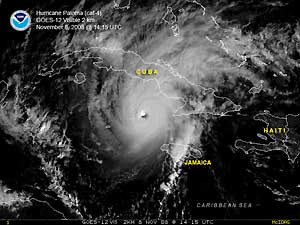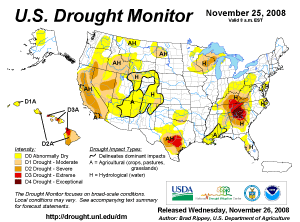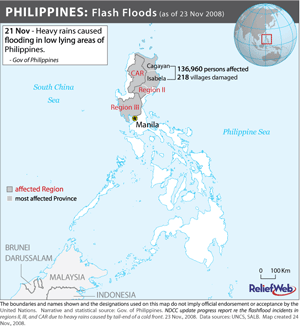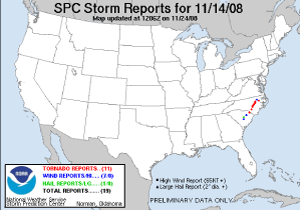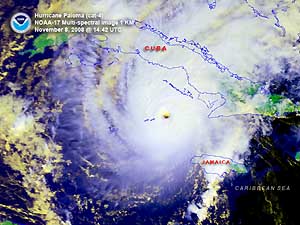
Global Hazards and Significant Events
November 2008
Hurricane Paloma became the second strongest November hurricane on record, behind Hurricane Lenny in 1999. Additional information can be found below.

In the United States, moderate to severe drought were observed across parts of the western and north-central continental U.S. Meanwhile, severe to extreme drought conditions were present in the Hawaiian Islands, southern Texas and the southeastern U.S. Western South Carolina, southwestern North Carolina, and northeastern Georgia had exceptional drought. As of November 25, 29% of the western U.S., 18% of the South, 7% of the High Plains, 30% of the Southeast, and 21% of the contiguous U.S. were in moderate to exceptional drought, according to the U.S. Drought Monitor.

In northern and central Vietnam, heavy rain which commenced during the last week of October, continued the first week of November. The rains generated devastating floods, claiming over 80 lives, turning streets into rivers, destroying nearly 600,000 acres of rice and crops, and submerging over 100,000 homes with floodwaters. According to reports, these were the worst floods to hit Vietnam in 25 years (BBC News).
Heavy rain fell during the week of November 9 across parts of South Africa, triggering widespread floods. The copious rains affected thousands of people, destroyed schools and roads, and were blamed for more than five fatalities (BBC News).
In Ethiopia, storms brought heavy rain that caused a river in the country's highlands to overflow. The floods were responsible for killing 11 people and 6,000 livestock, and destroying nearly 2,500 hectares of crops. More than 100 villages were inundated by the floods (Reuters).
Flooding triggered by torrential rains affected northern Philippines on November 17-23, causing six fatalities and submerging over 200 villages. The copious rain prompted rivers to burst their banks, damaging properties and crops. It was reported that the provinces of Isabela and Carayan were declared a state of calamity (BBC News).
Intense rains from November 20-23 affected areas across northern Venezuela. Devastating floods and deadly mudslides, triggered by the rains, claimed nine lives and were responsible for leaving hundreds of people homeless. The heavy rains also prompted several rivers to flow over their banks, which contributed to the severe flooding, turning streets into rivers and causing damages to homes and crops (BBC News).
Heavy rain on November 22-24 in southern parts of Brazil brought flooding and deadly mudslides, which affected 1.5 million people, paralyzed transportation, and resulted in 109 fatalities, with 19 others missing (AFP). It was reported that most of the fatalities were caused by mudslides that swept away homes and business. The heavy rain caused havoc across the region, leaving eight cities isolated due to overflowing rivers, and prompting the rupture of a pipeline that carries natural gas from Bolivia to Brazil, leading to gas shortages. Nearly 160,000 people were left without electricity and fresh water supplies (Associated Press/AFP/Reuters). This event has been described as the region's worst weather tragedy in history (AFP).
In Panama, flooding caused by heavy rain on November 22 claimed eight lives and affected over 14,000 people across the country. It was reported that the floods destroyed millions of dollars worth of crops (AFP).
In Sri Lanka, torrential rains during the last week of November prompted floods that killed seven people, displaced tens of thousands, and destroyed nearly 8,000 homes (Associated Press).

In Australia, severe storms caused havoc across the eastern coast during November 14-16. The storm's produced hail, strong winds, and heavy rain. The worst hit area was the city of Brisbane, which was lashed with 129 km/hr (80 mph or 70 knots) winds that downed power lines, leaving nearly 230,000 homes without power. It was reported that these storms were the most damaging Queensland has seen in over 25 years (BBC News).
In the United States, severe storms affected eastern North and South Carolina on the 15th, resulting in 11 preliminary reports of tornadoes. In North Carolina, two fatalities were blamed on the severe weather as the storms raked through the eastern part of the state. The storms affected six counties, destroying homes and downing tress and power lines (Associated Press). A detailed summary of the damage caused by the tornadoes is available, courtesy of the National Weather Service.

Hurricane Paloma formed in the Caribbean Sea, off the eastern coast of Nicaragua, as a tropical depression on November 5. The storm tracked north as it strengthened from tropical depression to tropical storm and then to a hurricane. As the storm came close to the Cayman Islands, Paloma was a Category 3 hurricane. The storm downed power lines, ripped off roofs, and caused flooding along the eastern and southern coasts of the island (BBC News/Caymanian Compass). The storm tracked to the east and further strengthened, reaching its peak intensity of maximum sustained winds near 222 km/hr (138 mph or 120 knots), a Category 4 hurricane, on November 8. Prior to landfall in Cuba, Paloma weakened to a Category 3 hurricane. On November 8, the storm made landfall in Santa Cruz del Sur, Cuba with maximum sustained winds near 193 km/hr (120 mph or 104 knots). Paloma made landfall in Santa Cruz del Sur, a day before celebrating the 76th anniversary of the 1932 November hurricane, which killed 3,000 people (AFP). Paloma lashed the western coast with nearly 10-foot-high waves and strong winds that washed away 50 homes and destroyed 435 homes. Heavy rain produced by the hurricane caused floods that inundated homes and washed out banana crops (Associated Press). However, no fatalities were reported. By November 9, Paloma had weakened into a tropical depression. Hurricane Paloma became the second strongest November hurricane on record, behind Hurricane Lenny in 1999.
For 2008 basin tropical cyclone statistics, please refer to the following:
Australian Basin
North Indian Ocean Basin
Western North Pacific Basin
South Pacific Basin
South Indian Ocean Basin
Northeast Pacific Ocean Basin
Atlantic Basin

No reports of significant extratropical cyclones were received during November 2008.

Cold weather and heavy snowfall affected parts of New Zealand on November 4. It was reported that 20 cm (8 inches) of snow fell across parts of northern Southland, forcing the organizers of the Tour of Southland cylce race to shorten some parts of the race due to the conditions. According to reports, residents described it as the worst November snowfall in three decades (BBC News).
 NOAA's National Centers for Environmental Information
NOAA's National Centers for Environmental Information
